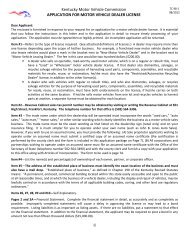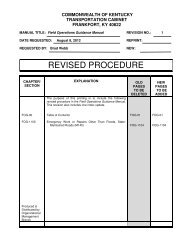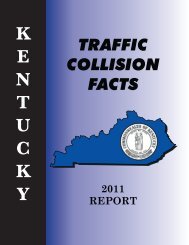woodland period moundbuilders of the bluegrass - Kentucky ...
woodland period moundbuilders of the bluegrass - Kentucky ...
woodland period moundbuilders of the bluegrass - Kentucky ...
- No tags were found...
You also want an ePaper? Increase the reach of your titles
YUMPU automatically turns print PDFs into web optimized ePapers that Google loves.
Since <strong>the</strong> Depression era, <strong>the</strong> pace <strong>of</strong> Adena mound research in <strong>the</strong>Bluegrass has slowed, but it has not stopped. Archaeologists are stillrecording and describing new mounds. They excavate <strong>the</strong>m only rarely,for example, when modern construction projects cannot avoid <strong>the</strong>m. In2006, archaeologists got <strong>the</strong>ir first glimpse <strong>of</strong> an Adena <strong>of</strong>f-mound ritualarea. It was near a Montgomery County burial mound that archaeologistshad recorded in 1932.Although research today builds on <strong>the</strong> work <strong>of</strong> Webb and hiscolleagues, archaeologists have moved beyond simply describing what<strong>the</strong>y find. Their goals are to interpret and understand all aspects <strong>of</strong>Adena life. For <strong>the</strong> past thirty years, native son Dr. R. Berle Clay hasresearched Adena burial ritual. He has drawn on <strong>the</strong> findings <strong>of</strong> his ownexcavations, but has relied equally on Depression-era materials. His workhas shown how complex and diverse Adena burial practices were. O<strong>the</strong>rinvestigators have begun to study how Adena people gotcopper from distant places, research that also depends onmaterials curated at <strong>the</strong> William S. Webb Museum.Archaeologists now recognize that a fullunderstanding <strong>of</strong> Adena culture will depend onknowing more about peoples’ day-to-day lives.Thus, some have begun to research <strong>the</strong> placesAdena people once lived. They are using newtechniques to collect new kinds <strong>of</strong> information.For example, a technique developed in <strong>the</strong>1970s, called flotation, recovers charred foodremains from soil using water separation. Nowarchaeologists study <strong>the</strong> kinds <strong>of</strong> plants Adenapeoples grew, ate, and used at home and in<strong>the</strong>ir ceremonies. We really have only begunto learn about Adena people: <strong>the</strong>ir domesticlife, <strong>the</strong>ir foodways, <strong>the</strong>ir biology anddiseases, where <strong>the</strong>y lived and why, and <strong>of</strong>course, <strong>the</strong>ir fascinating ritual lives.an Adena spearpoint with a rounded stem10
















